News |
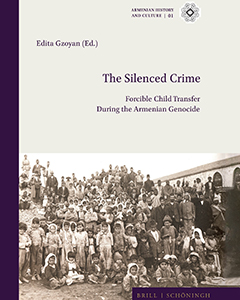
New Publication Marking the 110th Anniversary of the Armenian Genocide
The Silenced Crime: Forcible Child Transfer During the Armenian Genocide
16.04.2025
In commemoration of the 110th anniversary of the Armenian Genocide, the Armenian Genocide Museum-Institute (AGMI) presents The Silenced Crime: Forcible Child Transfer During the Armenian Genocide, a scholarly volume edited by AGMI Director Dr. Edita Gzoyan.
This publication features contributions from AGMI researchers Dr. Edita Gzoyan, Dr. Regina Galustyan, Dr. Narine Margaryan, Dr. Shushan Khachatryan, Dr. Robert Tatoyan, Dr. Harutyun Marutyan, and French-Armenian historian Dr. Raymond Kévorkian, Chair of AGMI’s Board of Trustees. The volume is published in collaboration with the Institute for Armenian Studies at Yerevan State University and constitutes the inaugural volume of the newly launched Armenian History and Culture series by Brill | Schöningh (Series link: https://brill.com/view/serial/AHUC). The series is co-edited by Dr. Ashot Hayruni and Dr. Robert Sukiasyan.
The contributors’ research focuses on various aspects of the forcible transfer and assimilation of Armenian children during the genocide—as a systematic policy by the Young Turk regime aimed at eradicating Armenian identity. Armenian children were targeted as part of a broader genocidal strategy: they were forcibly separated from their roots and placed in Muslim households or state-run orphanages. Through a combination of official decrees and individual initiatives, a systematic erasure of their national identity took place—through religious conversion, changes to personal data, and concealment of their true origins.
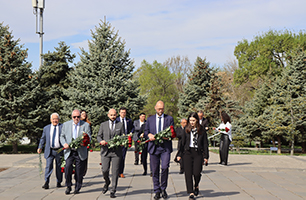
A Delegation Led by Christophe Quiniou, Mayor of Meyzieu, France, Visits the Armenian Genocide Memorial Complex
03.04.2025
On April 3, a French delegation led by Christophe Quiniou, Mayor of Meyzieu, visited the Armenian Genocide Memorial Complex. The group was accompanied by representatives of the Hrazdan Municipality, along with Olivier Decottignies, Ambassador Extraordinary and Plenipotentiary of France to the Republic of Armenia.
The delegation was welcomed by Lusine Abrahamyan, Deputy Director for Museum Affairs at the Armenian Genocide Museum-Institute (AGMI), who guided the guests through the Memorial Complex. During the tour, Abrahamyan provided historical context on the creation of the memorial and emphasized the significance of the three khachkars (cross-stones) erected in memory of Armenians killed during the late 20th-century pogroms in Sumgait, Kirovabad (Gandzak), and Baku.
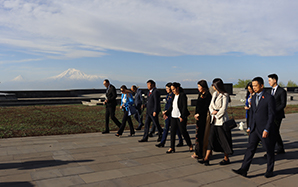
A Delegation Led by Ms. Le Thu Hai, Head of the Vietnam-Armenia Friendship Group, Visits the Armenian Genocide Memorial Complex
03.04.2025
On April 3, a delegation led by Ms. Le Thu Hai, Deputy Chief of Staff of the National Assembly of the Socialist Republic of Vietnam and Head of the Vietnam-Armenia Friendship Group, visited the Armenian Genocide Memorial Complex. The delegation was accompanied by Ms. Hasmik Hakobyan, Head of the Armenia-Vietnam Friendship Group of the National Assembly of Armenia.
The guests were welcomed by Dr. Edita Gzoyan, Director of the Armenian Genocide Museum-Institute (AGMI), who provided a guided tour of the Memorial Complex and spoke about the history of its establishment.
Ms. Le Thu Hai laid a wreath at the memorial in tribute to the victims of the Armenian Genocide. The delegation then placed flowers at the eternal flame and observed a moment of silence in memory of the innocent victims.
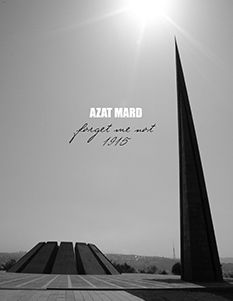
Garen Chobanyan, Founder of Azat Mard, Donates to the Armenian Genocide Museum-Institute
01.04.2025
As we near the 110th anniversary of the Armenian Genocide, the Armenian Genocide Museum-Institute (AGMI) has received a generous donation from Azat Mard, a company founded by Garen Chobanyan, a descendant of genocide survivors. This donation is aimed at supporting the technical development of the Museum through the modernization of essential equipment.
The AGMI extends its sincere appreciation to Garen Chobanyan, whose unwavering commitment to Armenia is evident in every endeavor he undertakes. Azat Mard has been actively involved in numerous charitable initiatives across Armenia, and this latest contribution stands as yet another powerful example of efforts to preserve and promote Armenian heritage, culture, and national identity.
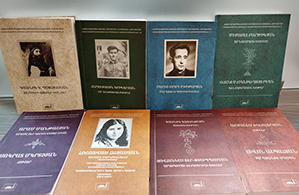
Anonymous Donation Brings Genocide Survivor Memoirs to Schools Participating in AGMI Programs
19.03.2025
An anonymous Armenian benefactor has recently made a generous contribution by purchasing 36 copies each of eight Armenian-language volumes from the Memoirs of Armenian Genocide Survivors series, published by the Armenian Genocide Museum-Institute (AGMI). The selected volumes—3 through 7, 9, 10, and 12—were acquired from the AGMI bookstore and donated to the Museum’s Educational Programs Department for distribution to school libraries.
Thanks to this thoughtful donation, two schools currently participating in AGMI’s educational programs have already enriched their libraries with these valuable memoirs.
These personal narratives and survivor testimonies serve as an essential resource for both education and research on the Armenian Genocide. It is vital that students engage with these firsthand accounts to deepen their understanding of history, memory, and resilience.
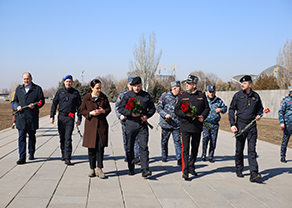
Commander of the Public Security Service of the Republic of Lithuania, Major General Viktoras Grabauskas Visited The Armenian Genocide Memorial and Musuem
11.03.2025
On March 7, a delegation led by Major General Viktoras Grabauskas, Commander of the Public Security Service of the Republic of Lithuania and international expert, visited the Armenian Genocide Memorial. The visit took place within the framework of the "Support to Law Enforcement and Security Sector Reforms in Armenia" program.
The delegation was welcomed by Dr. Edita Gzoyan, Director of the Armenian Genocide Museum-Institute (AGMI), who provided a guided tour of the Armenian Genocide Memorial Complex and shared the history of its establishment. Dr. Gzoyan also drew attention to the three khachkars (cross-stones) installed at Tsitsernakaberd in memory of Armenians killed in the massacres organized by the Azerbaijani government in Sumgait, Kirovabad (Gandzak), and Baku at the end of the 20th century.
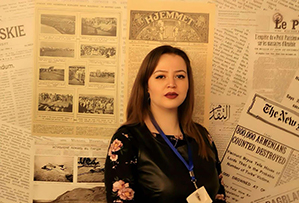
Funding Secured for Two AGMI Scientific Projects within the Framework of 2025 Research Support Programs
02.03.2025
Two scientific projects from the Armenian Genocide Museum-Institute (AGMI) have been awarded funding within the framework of the “Granting Program for Improving Scientific Efficiency – 2025” and the “Youth Scientific Research Support Program – 2025”, both initiatives of the Committee on Higher Education and Science.
The project titled “Turkish-Azerbaijani Language Propaganda Discourse”, led by AGMI researcher, PhD, and Associate Professor Elina Mirzoyan, has been selected for funding under the “Scientific Efficiency Promotion Grant Program – 2025.” The research will be carried out by a multidisciplinary team from various AGMI departments, with Dr. Bedros Der Matossian, Professor of History at the University of Nebraska–Lincoln, participating as the international partner.
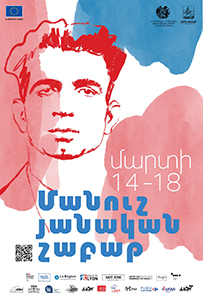
Manushian Week in Armenia
01.03.2025
From March 14 to 18, Yerevan and Artashat hosted "Manushian Week," an event dedicated to Misak Manushian and his comrades-in-arms in the French Resistance movement. The Armenian Genocide Museum-Institute (AGMI) was among the participating institutions.
As part of the program, AGMI hosted an international conference titled “From CUP Nationalism to Nazism: Armenian Genocide Survivors at the Forefront of the Resistance Movement,” which took place on March 15 and 16.
The goal of Manushian Week was to redefine the legacy of Misak Manushian, highlight his contribution to the global resistance movement, and foster French-Armenian historical and cultural dialogue.
The program included a wide array of events such as theatrical performances, conferences, exhibitions, documentary film screenings, and panel discussions. Highlights included the presentation of the book “Misak Manushian: Through the Eyes of an Eyewitness,” performances of the play “Manushian...,” the premiere of Shoshana Bukhobza’s play “Manushian,” and a screening of Katya Giragosyan’s documentary “Misak and Meline.”

Mayor of Saint-Étienne Visits Armenian Genocide Memorial Complex
01.03.2025
On March 1st, a delegation led by Gaël Perdriau, Mayor of Saint-Étienne, visited the Armenian Genocide Memorial Complex, accompanied by Kapan’s Deputy Mayor, Gor Tadevosyan. The delegation also included Vrezh Khosrovyan, President of the Armenian Association of Saint-Étienne, and Jean-Pierre Kotchian, the Mayor’s advisor and a descendant of an Armenian Genocide survivor.
The guests were received by Dr. Edita Gzoyan, Director of the Armenian Genocide Museum-Institute (AGMI), who guided them through the Memorial Complex and shared the history of its creation.
During the visit, Mayor Perdriau laid a wreath at the monument commemorating the victims of the Armenian Genocide. The delegation then placed flowers at the eternal flame and observed a minute of silence in memory of the innocent victims.
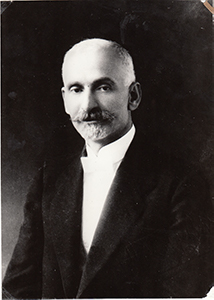
NATIONAL FIGURE HOVHANNES TOUMANYAN
19.02.2025
In parallel to orphan care activities Hovhannes Toumanyan has initiated and realized a number of projects aimed at solving the consequences of the Armenian Genocide.
On March 1918, the Union of Armenian Compatriotic Unions was established under the presidency of Hovhannes Toumanyan. Concentraiting the activities of the patriotic unions established in different Armenian provinces around him, Hovh. Toumanyan has carried out extensive work to organize fundraising to provide material support to the Armenian refugees, as well as ensure the peaceful coexistence of Armenians with neighboring nations (including Muslims). On behalf of the Union of Armenian Compatriotic Unions and the Armenian Writers Union, Toumanyan has called on the parliaments, academies, universities, and scientific societies of different countries in the world, describing the hard plight of the Armenian people and asking for moral and material aid.
On 31 October 1918, the day after the defeat of the Ottoman Empire in World War I and the conclusion of the Mudros armistice, a meeting of the Central Council of the Armenian Compatriotic Unions was held in Tbilisi, where it was decided to submit a memorandum to the Paris Peace Conference to be held in 1919. In order to prepare the memorandum War Victims Relief Committee was established under the leadership of Hovhannes Toumanyan. In a short time this state committee has undertaken an extensive work to record and legalize the human and material losses of Armenian people during the war.
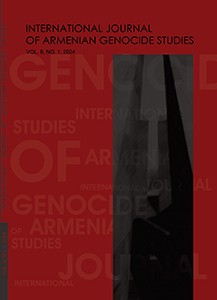
International Journal of Armenian Genocide Studies 2024
issues 1 and 2
18.02.2025
Read the following articles in the latest 2 issues of the International Journal of Armenian Genocide Studies, published by the Armenian Genocide Museum-Institute Foundation:
International Journal of Armenian Genocide Studies, Vol. 9 No. 1 (2024)
• Nagothu Naresh Kumar, Networks of Denial and Justification: South Asia Responses to the Armenian Genocide
• Ozlem Karakus, Echoes of Loss: Examining Gendered Violence and Legacy in the Armenian Genocide
• Sossi Tatikyan, Legal and Political Aspects of the De-Armenization of Nagorno-Karabakh: Ethnic Cleansing, Genocide, Forced Displacement or Voluntary Exodus?
• David Hackett, "Sieves of Responsibility" - Connecting Failures of Genocide Prevention and Geopolitical Interests to Atrocity in Nagorno Karabakh
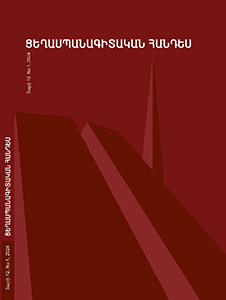
Journal of Genocide Studies 2024
Issues 1 and 2
15.02.2025
Read the following articles in the latest 2 issues of the Journal of Genocide Studies, published by the Armenian Genocide Museum-Institute Foundation:
Issue 1, 2024;
• Robert A. Tatoyan, The Armed Resistance of the Exiled Zeytun Armenians in the Desert of Der Zor
• Verjine G. Svaslian, The Armenian Woman During the Genocide and Self-Defense Heroic Struggles: Episodes
• Anna A. Kazaryan, The Forced Deportation of the Armenian Population from the Kghi District of Erzurum Province: From Kghi to Der Zor
• Narek M. Poghosyan, Contemporary Threats of the Implementation of the Genocide

French Audio Guides Now Available at the Armenian Genocide Museum-Institute
14.02.2025
Thanks to the cooperation and financial support of the leadership of France’s Auvergne-Rhône-Alpes region, the Armenian Genocide Museum-Institute has introduced French-language audio guides. The museum's existing guide texts have been translated into French and professionally recorded, allowing Francophone visitors to explore the exhibits independently. Given the significant number of French-speaking visitors, the addition of these audio guides is both necessary and valuable.
Collaboration with the Auvergne-Rhône-Alpes region began in 2020, resulting in the publication of a French-language edition of The Slaughtered Armenia: The Story of Aurora Mardiganian. Most recently, with the region’s financial support, a French edition of The Armenian Genocide and its Consequences by historian and Chairman of the Armenian Genocide Museum-Institute Board of Trustees, Raymond Kévorkian, has also been published.
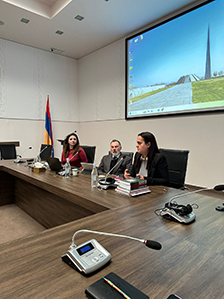
The presentation of the book “Secret Nation: The Hidden Armenians of Turkey (I.B. Tauris, 2018)” by Avedis Hadjian at AGMI
11.02.2025
On February 6, a presentation and discussion of Avedis Hadjian’s book Secret Nation: The Hidden Armenians of Turkey (I.B. Tauris, 2018) took place at the Armenian Genocide Museum-Institute. Before the event began, Edita Gzoyan, the Director of the Museum-Institute, greeted the attendees. Shushan Khachatryan, Head of the Department for Documentation and Research on the Victims and Survivors of the Armenian Genocide, then introduced the speaker.
Avedis Hadjian presented his book, which is made up of 32 chapters, each dedicated to a specific geographic and cultural region: Sasun, Commagene, Diyarbekir, Taron, Karin, Sebastia, Asia Minor, Kharberd, Van, Cilicia, the Black Sea, and Hamshen. The author conducted his research using interviews and oral history methods, traveling to these regions and engaging with individuals and families who, due to the Armenian Genocide, had either lost their Armenian identity but still retained some memory of their roots, or those who still identified as Armenians—including some who were hidden Christian Armenians.
The author presented unique photographs, each accompanied by the story behind it. At the end of the presentation, he responded to questions from the audience.
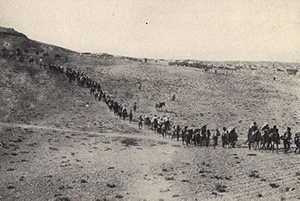
We continue to highlight the publications of AGMI researchers in international journals
07.02.2025
An article by Edita Gzoyan, Director and Senior Researcher at the Armenian Genocide Museum-Institute (AGMI), titled "From War Crimes to Crimes against Humanity and Genocide: Turkish Responsibility after World War I," has been published in Genocide Studies International: https://utppublishing.com/doi/10.3138/GSI-2022-0020.
The article examines the work of the Commission on the Responsibility of the Authors of the War and Enforcement of Penalties, established after World War I to investigate war crimes, including those committed against Armenians during the Armenian Genocide.
Drawing on evidence from various sources, the Commission’s report explicitly identifies the crimes perpetrated by the Young Turk government against the Armenian population of the Ottoman Empire, namely:
1. Mass killings, massacres, and systematic terror.
2. Abduction of women and young girls.
3. Deportation of civilians.
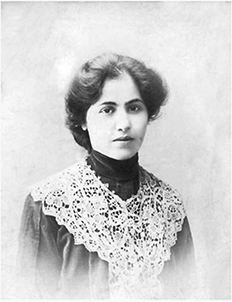
ZABEL YESSAYAN, 1878-1943
04.02.2025
Zabel Yessayan was born on February 4th, 1878, in Constantinople (Istanbul). After graduating from the Holy Cross school in Uskudar, she went to Paris in December 1895, where she attended lectures on literature and philosophy at the Sorbonne and the College de France.
She married the artist Dikran Yessayan (1874-1921) in 1900. After considerable activity in the literary and public fields in Paris, she returned to Constantinople in 1902, where she continued her literary activities.
Due to the social and national-political repression and persecution that began after the attempt on Sultan Abdul-Hamid II’s life, she was forced to return to Paris, where she lived until 1908.
Zabel Yessayan spent about three months in Adana, Mersin, Sis, and other places after the massacres, meeting eyewitnesses and survivors and writing a number of works describing what she saw and heard (In the Ruins, The Curse, The New Bride, Safie).
She was on the secret list of intellectuals to be deported on the night of April 24th. Escaping deportation, she spent several months living in disguise, after which she went to Bulgaria, Romania, and, eventually, at the end of 1915, the Caucasus. She had a number of meetings in both Baku and Tiflis (Tbilisi), joined various important enterprises, and gave lectures. She went to St. Petersburg and Moscow at the invitation of the Moscow Armenian Committee, where she organized fundraising for the benefit of Armenian orphans and presented the real picture of the Armenian massacres.
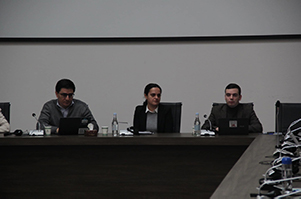
ARMENIA AND THE INTERNATIONAL CRIMINAL COURT: ONE YEAR OF MEMBERSHIP
Workahop at AGMI
04.02.2025
On February 1, a professional seminar titled “Armenia and the International Criminal Court (ICC): One Year of Membership” was held at the Armenian Genocide Museum-Institute. The seminar was organized jointly by the Union of International Lawyers of Armenia and the Museum-Institute. It brought together international law experts, legal professionals interested in international criminal law, individuals engaged in interdisciplinary studies, as well as professors and students.
The event began with a welcoming speech by Edita Gzoyan, Director of the Museum-Institute. Drawing historical parallels, Edita Gzoyan emphasized that after the Armenian Genocide, there was no international law or court to punish the perpetrators, but now the situation has changed. She expressed hope that Armenia's membership in the ICC would also provide a legal framework to fight for the rights of our compatriots forcibly displaced from Artsakh.
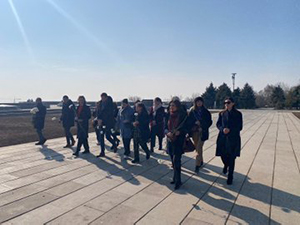
Representatives of Local Government Bodies of France Visit the Armenian Genocide Memorial Complex
03.02.2025
At the invitation of the United Nations Development Program (UNDP) and the French Embassy in Armenia, representatives of France's local government bodies visited the Armenian Genocide Memorial Complex on February 2, accompanied by the Ambassador Extraordinary and Plenipotentiary of France to Armenia, Olivier Decottignies, and representatives of the UNDP.
They were greeted by Lusine Abrahamyan, AGMI Deputy Director for Museum affairs. She guided the visitors to the Memorial Complex, sharing the history of its establishment. The Deputy Director also spoke about three khachkars (cross-stones) installed in the Tsitsernakaberd area, which commemorate the Armenians who were victims of the massacres organized by the Azerbaijani government in the cities of Sumgait, Kirovabad (Gandzak), and Baku at the end of the last century. She also presented the stories of five freedom fighters who were buried near the Memorial Wall during the Artsakh Liberation War, emphasizing the connection between these events and the Armenian Genocide.
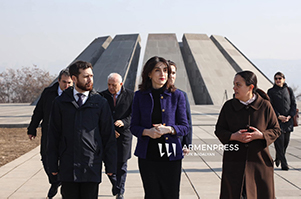
Georgian Foreign Minister Maka Bochorishvili visited the Armenian Genocide Memorial Complex
30.01.2025
On January 30, Maka Bochorishvili, the Minister of Foreign Affairs of Georgia, arrived in Armenia on an official visit and visited the Armenian Genocide Memorial Complex.
The Georgian minister was greeted by Edita Gzoyan, Director of the Armenian Genocide Museum-Institute (AGMI), who guided her to the Memorial Complex and shared the history of its establishment. The Director also spoke about the three khachkars (cross-stones) placed in the Tsitsernakaberd area to commemorate the Armenians who were victims of the massacres organized by the Azerbaijani government in the cities of Sumgait, Kirovabad (Gandzak), and Baku at the end of the last century, emphasizing the connection between these events and the Armenian Genocide.
The Georgian Minister laid a wreath at the memorial to honor the victims of the Armenian Genocide. Afterward, the guests placed flowers near the Eternal Fire and observed a minute of silence to pay their respects to the innocent martyrs of the Armenian Genocide.
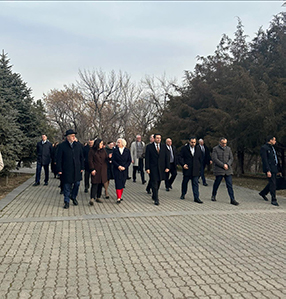
Representatives of the Parliaments of Northern Europe and the Baltic States (Nordic-Baltic-8) Visited the Armenian Genocide Memorial Complex
23.01.2025
On January 23, 2025, representatives of the parliaments of Northern Europe and the Baltic countries (Norway, Finland, Estonia, Latvia, Lithuania, Sweden, and Denmark), including the Speakers of the Parliaments of Norway, Finland, Estonia, and Latvia, as well as the Deputy Speakers of the Parliaments of Sweden, Lithuania, and Denmark, visited the Armenian Genocide Memorial Complex, accompanied by Alen Simonyan, the Speaker of the National Assembly of Armenia.
The delegation was welcomed by Edita Gzoyan, Director of the Armenian Genocide Museum-Institute (AGMI), who guided the visitors to the Memorial Complex and shared the history of its establishment.
The members of the Northern European and Baltic delegations laid wreaths at the memorial dedicated to the victims of the Armenian Genocide. Afterward, they placed flowers around the Eternal Fire and observed a minute of silence in memory of the innocent martyrs.
Dr. Gzoyan also guided the visitors to the Memory Wall presenting its history. Behind the wall, in special niches, are small urns filled with soil taken from the graves of various foreign public figures, political leaders, intellectuals, and missionaries who raised their voices in protest against the mass massacres and genocide of Armenians carried out by the Ottoman government in the late 19th and early 20th centuries.
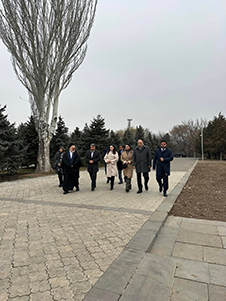
The Iran-Armenia Friendship Group of the Majlis of the Islamic Republic of Iran visited the Armenian Genocide Memorial Complex
14.01.2025
A delegation led by Ara Shahverdyan, head of the Iran-Armenia Friendship Group of the Majlis of the Islamic Republic of Iran, visited the Armenian Genocide Memorial Complex on January 14.
The guests were greeted by Lusine Abrahamyan, AGMI Deputy Director for Museum affairs. She guided the visitors to the Memorial Complex, sharing the history of its establishment. The Deputy Director also spoke about three khachkars (cross-stones) installed in the Tsitsernakaberd area, which commemorate the Armenians who were victims of the massacres organized by the Azerbaijani government in the cities of Sumgait, Kirovabad (Gandzak), and Baku at the end of the last century. She also presented the stories of five freedom fighters who were buried near the Memorial Wall during the Artsakh Liberation War, emphasizing the connection between these events and the Armenian Genocide.
Dear visitor,
The Armenian Genocide Museum-Institute will be closed from December 30 till January 2, 2025.
Sincerely,
The Armenian Genocide Museum-Institute Foundation
|
News of site |
|
08.01.2020 Update site: The Armenian Genocide Museum-institute
|
|
DONATE |

TO KEEP THE MEMORY OF THE ARMENIAN GENOCIDE ALIVE
Special Projects Implemented by the Armenian Genocide Museum-Institute Foundation
|
COPYRIGHT |

|
AGMI BOOKSTORE |
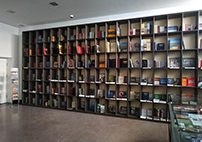
The Armenian Genocide Museum-Institute’s “World of Books”
|
TESTIMONIAL OF ARMENIAN GENOCIDE SURVIVORS |
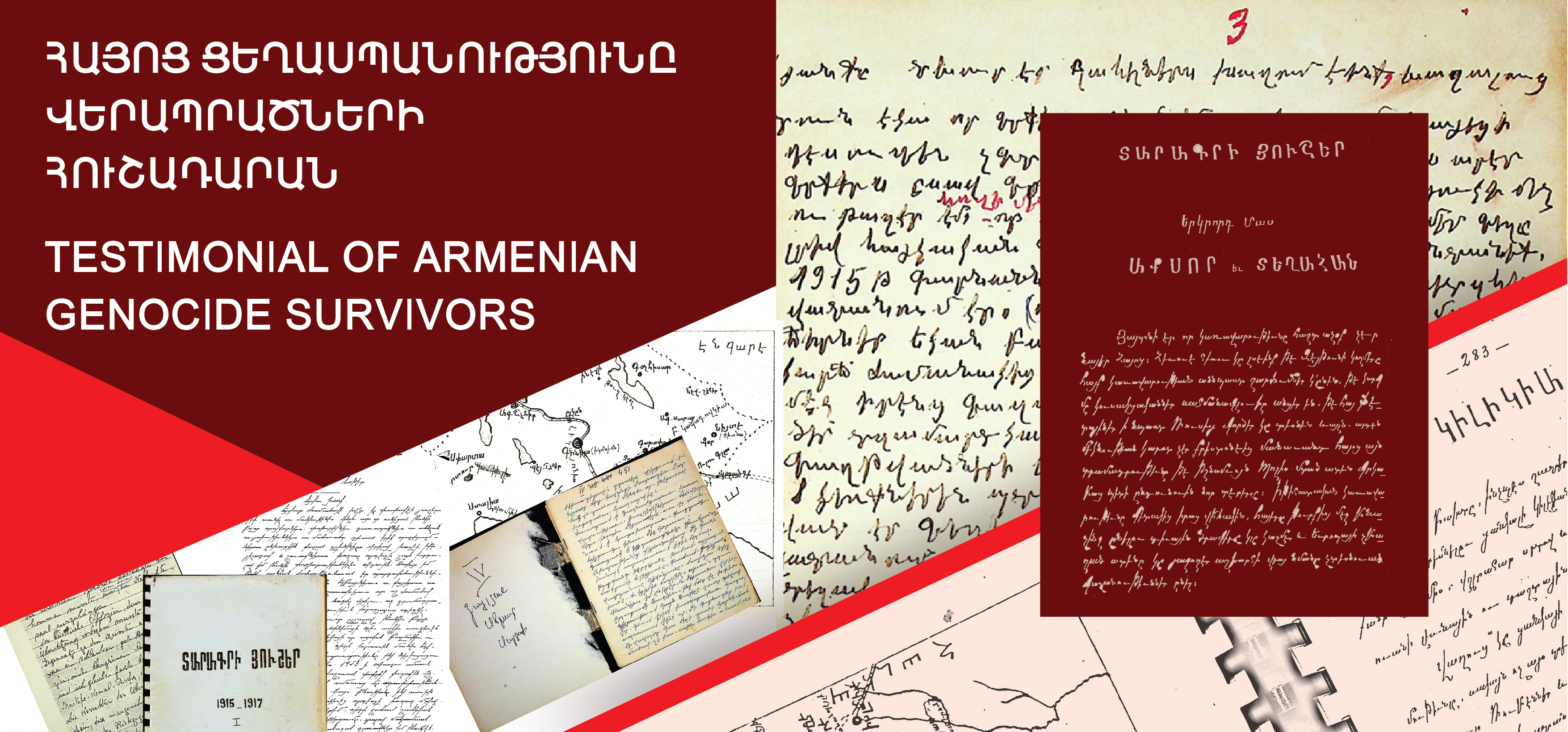
THE AGMI COLLECTION OF UNPUBLISHED MEMOIRS
|
ONLINE EXHIBITION |

SELF-DEFENSE IN CILICIA DURING THE ARMENIAN GENOCIDE
DEDICATED TO THE CENTENNIAL OF THE SELF-DEFENSE BATTLES OF MARASH, HADJIN, AINTAB
|
LEMKIN SCHOLARSHIP |

AGMI ANNOUNCES 2024
LEMKIN SCHOLARSHIP FOR FOREIGN STUDENTS
|
TRANSFER YOUR MEMORY |
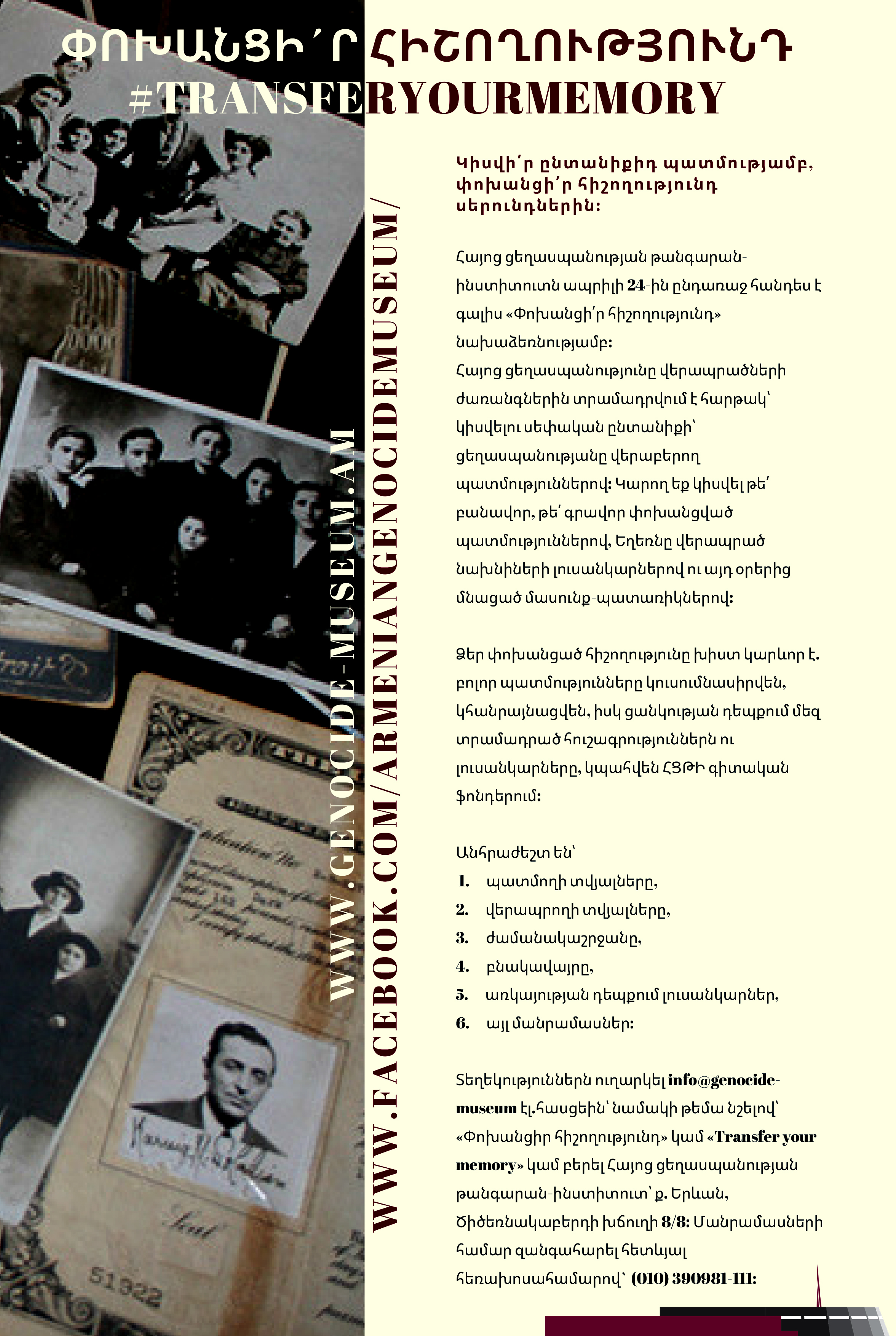
Share your family story,
Transfer your memory to generations.
On the eve of April 24, the Armenian Genocide Museum-Institute undertakes an initiative “transfer your memory”.
|
|





